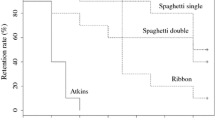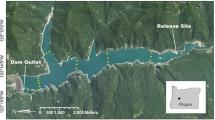Abstract
Fish tagging methods are important tools in the research and management of salmonids; the Carlin tag is widely used, especially in anadromous salmonids. However, this tagging method may interfere with fish behaviour and increase post-smolt mortality. To estimate Carlin-tag-inflicted mortality in Arctic charr, we used jet injection of alcian blue (colour tags) as a control. Recapture rates were higher for the colour-tagged fish than for the Carlin-tagged fish for both one- and two-year-old smolts. For one-year-old smolts in 1992, the recapture rate was 18.9% for colour-tagged fish and 10.0% for Carlin-tagged ones. For two-year-old smolts in the same year, 34.0% of colour- and 28.6% of Carlin-tagged fish were recaptured; in 1993, recapture rates were 17.2% and 6.3% for colour- and Carlin-tagged fish, respectively. Colour-tagged one-year-old Arctic charr also grew faster than their Carlin-tagged counterparts. No differences in growth rates were found between tagging methods in two-year-olds. These results imply that for hatchery-reared Arctic charr, survival rates using Carlin tagging may be half to one third that of colour tagging. Growth was also higher among colour-tagged fish, indicating that Carlin tags alter the behaviour of fish in the sea.
Similar content being viewed by others
References cited
Berg, O.K. & M. Berg 1987. Effects of Carlin tagging on the mortality and growth of sea trout (Salmo trutta L.). Fauna Norvegica Series A 8: 15–20.
Berg, O.K. & M. Berg 1989. Sea growth and time of migration of anadromous Arctic char (Salvelinus alpinus) from Vardnes River, in northern Norway. Can. J. Fish. Aquat. Sci. 46: 955–960.
Berg, O.K. & M. Berg 1990. Effects of Carlin tagging on the mortality and growth of anadromous Arctic char, Salvelinus alpinus (L). Aquat. Fish. Manage. 21: 221–227.
Bergman, P.K., F. Haw, H.L. Blankenship & R.M. Buckley. 1992. Perspectives on design, use and misuse of fish tags. Fisheries 17(4): 20–25.
Carlin, B. 1955. Tagging of salmon smolts in the River Lagan. Rep. Inst. Freshwat. Res. Drott. 36: 57–74.
Carline, R.F. & O.M. Brynhildson. 1972. Effects of the Floy anchor tag on the growth and survival of brook trout (Salvelinus fontinalis). J. Fish. Res. Board Can. 29: 458–460.
Dill, L.M. 1983. Adaptive flexibility in the foraging behaviour of fishes. Can. J. Fish. Aquat. Sci. 40: 398–408.
Eames, M.J. & M.K. Hino. 1983. An evaluation of four tags suitable for marking juvenile chinook salmon. Trans. Amer. Fish. Soc. 125: 261–273.
Feltham, M.J. & J.C. McLean. 1996. Carlin tag recoveries as an indicator of predation on salmon smolts by goosanders and red-breasted mergansers. J. Fish Biol. 48: 270–282.
Finstad, B. & T.G. Heggberget. 1993. Migration, growth and survival of wild and hatchery-reared anadromous Arctic charr (Salvelinus alpinus) in Finnmark, northern Norway. J. Fish Biol. 43: 303–312.
Gerking, S.D. 1963. Non-mutilation mark for fish. Spec. Pub. Int. Comm. NW. Atlant. Fish 4: 248–254.
Hansen, L.P. 1988. Effects of Carlin tagging and fin clipping on survival of Atlantic salmon (Salmo salar L.) released as smolts. Aquaculture 70: 391–394.
Hart, P.J.B. & T.J. Pitcher. 1969. Field trials of fish marking using jet inoculator. J. Fish Biol. 1: 383–385.
Haw, F.P., K. Bergman, R.D. Fralick, R.M. Buckley & H.L. Blankenship. 1990. Visible implanted fish tag. Amer. Fish. Soc. Symp. 7: 311–315.
Heggberget, T.G., O. Skilbrei, E.B. Thorstad, V. Moen & B.O. Johnsen. 2000. Tagging of hatchery produced salmon in Norway - potential methods, costs and effects. NINA Oppdragsmelding no. 640. 25 pp. (in Norwegian).
Herbinger, C.M., G.F. Newkirk & S.T. Lanes. 1990. Individual marking of Atlantic salmon: evaluation of cold branding and jet injection of Alcian Blue in several locations. J. Fish Biol. 36: 99–101.
Hvidsten, N.A. & R.A. Lund. 1988. Predation on hatcheryreared and wild smolts of Atlantic salmon, Salmo salar L., in the estuary of River Orkla, Norway. J. Fish Biol. 33: 121–126.
Isaksson, A. & P.K. Bergman. 1978. An evaluation of two tagging methods and survival rates of different age and treatment groups of hatchery-reared Atlantic salmon smolts. J. Agricult. Res. Iceland 10: 74–99.
Laird, L.M. & B. Stott. 1968. Marking and tagging. pp. 84–100. In: W.E. Ricker (ed.) Methods for Assessment of Fish Production in FreshWaters, IBP Handbook no. 3, Blackwell Scientific Publication, Oxford.
McAllister, K.W., P.E. McAllister, R.C. Simon & J.K. Werner. 1992. Performance of nine external tags on hatchery-reared rainbow trout. Trans. Amer. Fish. Soc. 121: 192–198.
McFarlane, G.A., R.S. Wydoski & E.D. Prince. 1990. Historical review of the development of external tags and marks. Amer. Fish. Soc. Symp. 7: 9–29.
Morgan, R.I.G. & R.J. Roberts. 1976. The histopathology of salmon tagging, Part 4, the effects of severe exercise on the induced tagging lesions in salmon parr at two temperatures. J. Fish Biol. 8: 289–292.
Mourning, T.E., K.D. Fausch & C. Gowan. 1994. Comparison of visible implant tags and Floy anchor tags on hatchery rainbow trout. N. Amer. J. Fish. Manage. 14: 636–642.
Nielsen, L.A. 1992. Methods for marking fish and shellfish. Amer. Fish. Soc. Special Publ. 23, Bethesda. 208 pp.
Reitan, O., N.A. Hvidsten & L.P. Hansen. 1987. Bird predation on hatchery reared Atlantic salmon smolts, Salmo salar L., released in the River Eira, Norway. Fauna Norv. Ser. A 8: 35–38.
Rikardsen, A. 2000. Effects of Floy and soft VIalpha tags on growth and survival of juvenile Arctic char. N. Amer. J. Fish. Manage. 20: 720–729.
Strand, R., A. Lamberg, B.O. Johnsen & T.G. Heggberget. 1996. Sea-ranching project in River Oplø y, Norway, NINA Oppdragsmelding no. 403. 24 pp. (in Norwegian)
Tranquilli, J.A. & W.F. Childers. 1982. Growth and survival of largemouth bass tagged with Floy anchor tags. N. Amer. J. Fish. Manage. 2: 184–187.
Zerrenner, A., D.C. Josephson & C.C. Krueger. 1997. Growth, mortality and mark retention of hatchery brook trout marked with visible implant tags, jaw tags and adipose fin clips. Progr. Fish Cult. 59: 241–245.
Author information
Authors and Affiliations
Rights and permissions
About this article
Cite this article
Strand, R., Finstad, B., Lamberg, A. et al. The Effect of Carlin Tags on Survival and Growth of Anadromous Arctic Charr, Salvelinus Alpinus . Environmental Biology of Fishes 64, 275–280 (2002). https://doi.org/10.1023/A:1016091619937
Issue Date:
DOI: https://doi.org/10.1023/A:1016091619937




